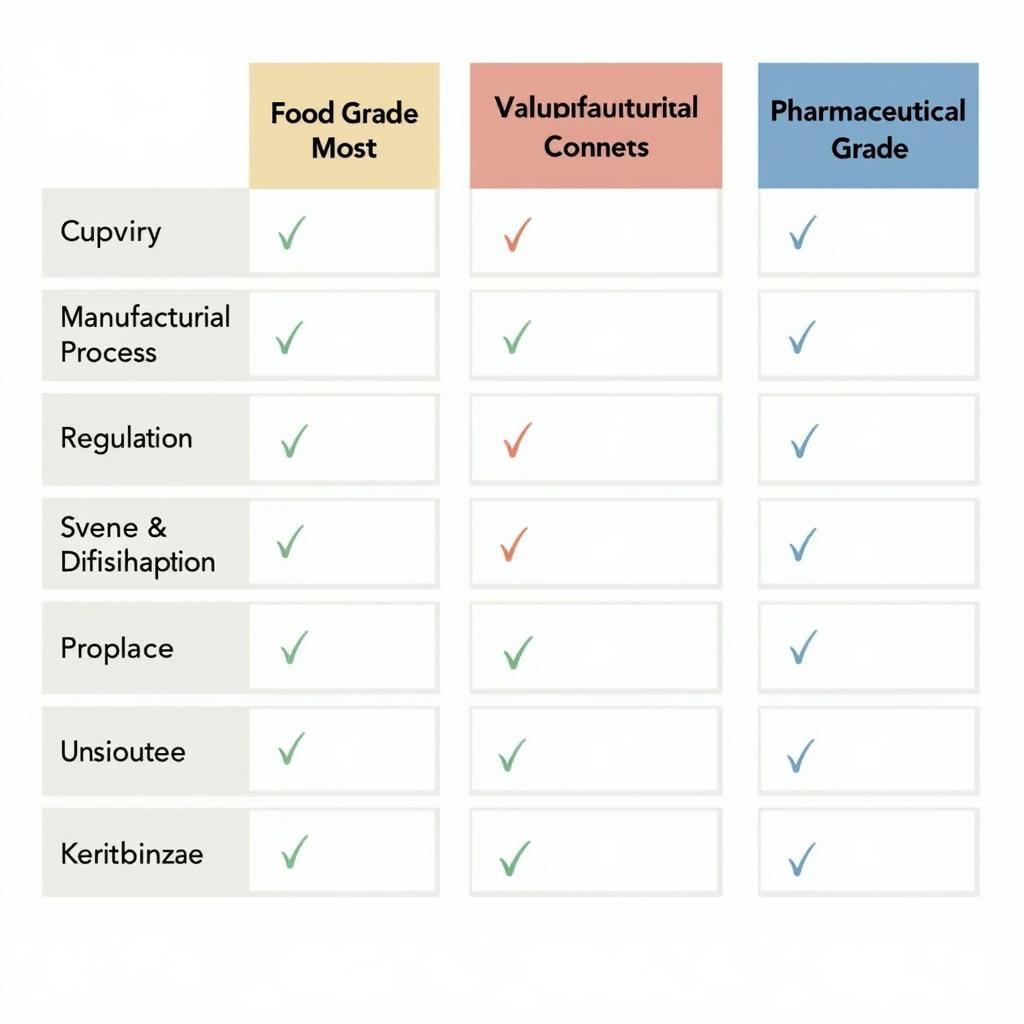Food grade and pharmaceutical grade are terms we often encounter, particularly when discussing ingredients and products. But what do these classifications actually mean and what’s the difference between them? Understanding these distinctions is crucial for making informed decisions about the products we consume and use.
Let’s delve deeper into the nuances of Food Grade Vs Pharmaceutical Grade, exploring the criteria that define each category and the implications for consumers. After reading this, you’ll be equipped to navigate the marketplace with confidence and choose products that align with your needs and priorities. We’ll also cover some common misconceptions surrounding these terms.
Decoding “Food Grade”
Food grade refers to substances that are safe for human consumption. These substances meet specific standards set by regulatory bodies, such as the FDA in the United States, ensuring they are free from harmful contaminants and meet certain purity levels. Food grade ingredients are used in a wide range of products, from the food we eat to dietary supplements and even some cosmetics. The standards for food grade materials focus primarily on ensuring safety for consumption and do not typically address the specific therapeutic effects or potency levels required for pharmaceuticals.
Exploring “Pharmaceutical Grade”
Pharmaceutical grade, on the other hand, designates substances held to a much higher standard of purity and quality control. These substances must adhere to strict regulations outlined in pharmacopoeias, such as the United States Pharmacopeia (USP), which dictate precise purity levels, manufacturing processes, and testing procedures. Pharmaceutical grade substances are used in the production of medications and other therapeutic products. The stringent requirements for pharmaceutical grade ensure the safety and efficacy of these substances for their intended medicinal purposes. They also ensure consistent dosage and predictable effects.
 Pharmaceutical Grade Production Facility
Pharmaceutical Grade Production Facility
Food Grade vs Pharmaceutical Grade: Key Differences
The primary difference between food grade and pharmaceutical grade lies in the level of purity and the stringency of the manufacturing processes. While both categories require a certain level of safety, pharmaceutical grade demands significantly higher purity and more rigorous quality control. This is essential to ensure the safety and effectiveness of medications. Let’s further break down these differences:
-
Purity Levels: Pharmaceutical grade substances boast a higher degree of purity than food grade substances, meaning they contain fewer impurities and contaminants.
-
Manufacturing Processes: Pharmaceutical grade manufacturing follows stricter guidelines and undergoes more rigorous testing than food grade manufacturing. This ensures the consistency and quality of the final product.
-
Regulations: Different regulatory bodies oversee food grade and pharmaceutical grade substances. Food grade materials are regulated by organizations like the FDA, while pharmaceutical grade substances are governed by pharmacopoeias.
What Does This Mean for Consumers?
Understanding these distinctions empowers consumers to make informed choices. While food grade products are safe for consumption, they may not deliver the same therapeutic benefits as pharmaceutical grade products. For instance, while a food grade supplement might contain a certain ingredient, its potency and purity may not match that of a pharmaceutical grade equivalent. This is a crucial factor when considering supplements or other products intended for specific health benefits.
200 proof food grade ethanol is an example of a product that can be both food grade and pharmaceutical grade depending on the intended use and purity.
Common Misconceptions
One common misconception is that “pharmaceutical grade” automatically implies superior quality for all purposes. However, this is not always the case. The higher purity of pharmaceutical grade substances is crucial for medications, but it doesn’t necessarily translate to added benefit in other contexts. For example, using pharmaceutical-grade salt in cooking won’t necessarily enhance the flavor or nutritional value compared to using food grade salt.
Another misconception is that food grade substances are somehow inferior. This is inaccurate. Food grade materials are perfectly safe for their intended use in food and other approved applications. They simply adhere to different standards tailored to their specific purpose.
Dr. Elizabeth Miller, a renowned chemist, explains, “The difference isn’t about one being ‘better’ than the other. It’s about suitability for the intended application. Pharmaceutical grade is necessary for the precise and controlled environment of drug manufacturing. Food grade is perfectly acceptable and safe for its designated purposes.”
food ethanol is another example of a substance with both food grade and pharmaceutical grade classifications, further demonstrating that the term “grade” refers to the intended use and purity level rather than inherent quality.
 Food Grade vs. Pharmaceutical Grade Comparison Chart
Food Grade vs. Pharmaceutical Grade Comparison Chart
Conclusion: Making Informed Choices
The distinction between food grade and pharmaceutical grade ultimately boils down to the intended use and the level of purity required. Understanding this difference enables us to make informed decisions about the products we choose, ensuring they are both safe and effective for their intended purpose. By considering the specific requirements of each application, we can confidently navigate the marketplace and select products that align with our individual needs and priorities. Remembering that “grade” indicates suitability rather than absolute quality will help you make the best choices for your health and well-being.
FAQ
- Is food grade safe? Yes, food grade substances are deemed safe for human consumption according to established standards.
- Is pharmaceutical grade always better? Not necessarily. Its higher purity is crucial for medications, but not always advantageous in other applications.
- Who regulates food grade substances? Organizations like the FDA regulate food grade materials.
- Who regulates pharmaceutical grade substances? Pharmacopoeias, such as the USP, regulate pharmaceutical grade substances.
- Can food grade substances be used in medicine? Generally, no. Medications require the higher purity and specific quality controls of pharmaceutical grade substances.
- What are examples of food grade substances? Common examples include salt, sugar, flour, and various food additives.
- What are examples of pharmaceutical grade substances? Active pharmaceutical ingredients (APIs) and excipients used in medications are examples of pharmaceutical grade substances.
Need further assistance? Contact us at Phone Number: 02437655121, Email: minacones@gmail.com or visit our address: 3PGH+8R9, ĐT70A, thôn Trung, Bắc Từ Liêm, Hà Nội, Việt Nam. We have a 24/7 customer service team.